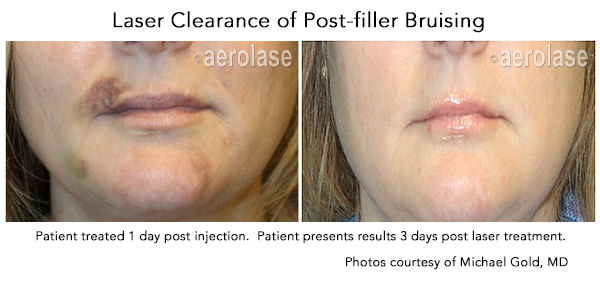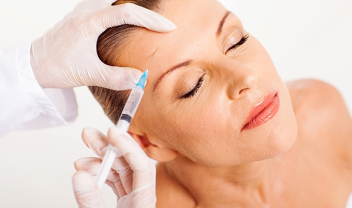The 2014 Plastic Surgery Statistics Report revealed that almost 9 million injectable procedures (botulinum

toxin A and soft tissue fillers) were performed – the two most popular minimally invasive procedures in the US. Known for their low rates of downtime and high rates of satisfaction, injectable procedures continue to grow in demand. Studies report that the most common adverse effects from injectable reactions is bruising with one study showing a 19-24 percent occurrence rate and others as high as 68 percent. Even the best injectors in the world can give a patient a bruise. It is completely unpredictable due to a number of intrinsic and extrinsic factors. When bruising does occur, it can cause the patient displeasure and anxiety knowing it can last up to several weeks.
Now, more than ever, patients seek less downtime from cosmetic procedures and, for many, up to several weeks with a bruise or other associated downtime deterring them from going out in public is unacceptable. What a lot of medical professionals do not know or do not practice is utilizing lasers to reduce downtime associated with bruising. “We [dermatologists and cosmetic practices] do a lot of cosmetic treatments and we bruise a lot of people. We always tell our toxin and filler patients that there is a possibility of bruising and, if you do, come back and we can treat it. We can take care of it in no time and make the bruise go away within a few days after a single laser treatment,” says dermatologist Michael Gold, MD of the Gold Skin Care Center.
The
Aerolase LightPod Neo 1064nm 650-microsecond laser has been reported to achieve significant results for the clearance of bruising after cosmetic procedures both on and off the face. Results have shown an accelerated healing process, which enhances both patient outcomes and overall satisfaction for all Fitzpatrick skin types.
Lasers have been used to treat post-injectable bruising for a number of years, but it is still not common practice. “A lot of practitioners don’t think about this, but it is integral to your treatment outcomes,” explains Dr. Gold. “You can do this with the LightPod Neo and you can do this with pulsed dye, but it is the range of what the Neo can do that practitioners are really interested about in this device.”
Improving upon the traditional gold standard for vascular conditions, the LightPod Neo advances the capabilities of pulsed-dye lasers, but within the 1064nm wavelength. The 1064nm wavelength inherently has a higher versatility and safety profile with equal or better efficacy without the risk of adverse reactions. The Neo’s technology allows for fluences from 4 J/cm2 to 255 J/cm2 within a short, 650-microsecond pulse duration so it is gentler on the skin without sacrificing power.
In a simple five-minute procedure, patients can achieve complete clearance in as little as 24 hours. A combination of high and low fluences is used to treat the entirety of the bruise. Darker areas are treated with a low fluence and a higher fluence is used to treat lighter areas of the bruise. Using the 650-microsecond pulse duration, the first pass, which covers the entire effected area(s), a spot size of 6mm and fluence of 21 J/cm2 is used. Then, still using the 650-microsecond pulse duration, but with a spot size of 2mm and fluence of 128 J/cm2, only the lighter portion of the bruise is covered. This technique allows for effective results without the risk of any further adverse reactions.
This treatment approach progresses the existing techniques for vascular conditions not only because of the wavelength, but also because of the combination of high fluence in a short pulse duration. As we know, the medical applications of laser technology are based on the principle of selective photothermolysis. This process has 3 prerequisites:
1) A laser wavelength that is preferentially absorbed by the targeted structure or chromophore – The Neo’s 1064nm wavelength is uniquely attracted to all 3 chromophores (hemoglobin, melanin and water) and will be absorbed by the hemoglobin.
2) An exposure duration less than or equal to the thermal relaxation time of the target tissue – The Neo’s short pulse duration (650µsec) is shorter than the skin’s thermal relaxation time (800µsec).
3) Sufficient laser energy per unit area (fluence) to reach damaging temperatures in the target structure with minimum collateral injury – The Neo has the ability to achieve high fluences (up to 255 J/cm2) within the 650µsec pulse duration.
Achieving these 3 prerequisites in a new, unique profile under these well established parameters make the Neo optimal for post-procedure bruises among many other applications – even on darker skin types without skin contact, cooling gels or sprays, which many other light based modalities are unable to safely or effectively treat.
The advantage of accelerated recovery aided by laser therapy does not solely apply to cosmetic injections. Both traditional and newer cosmetic procedures can benefit from it. Any downtime involving bruising from traditional, invasive procedures including breast augmentation, rhinoplasty, liposuction and others can be reduced with the help of lasers. Subsequently, even newer cosmetic procedures, that offer a less invasive, but effective treatment approach, encounter adverse effects with post procedure bruising still being the predominant occurrence. Two of the most popular treatments, cryolipolysis for stubborn body fat and deoxycholic acid injections for submental fat reduction, are novel non-invasive approaches for accelerated patient solutions. Even though each has relatively low rates of occurrence, certain adverse effects do occur i.e. bruising.
Patients undergoing cosmetic procedures continue to expect more from their provider and more from their procedures. The most skilled surgeon, injector or cosmetic practitioner can always improve the outcomes their patients desire. And that is what both practitioners and patients are seeking – better outcomes, higher satisfaction and reduced social downtime. Supplementing laser treatments to accelerate post procedure recovery times is a progressive way to advance your cosmetic treatments and
Aerolase laser technology offers a new advanced solution to this ongoing problem.





 toxin A and soft tissue fillers) were performed – the two most popular minimally invasive procedures in the US. Known for their low rates of downtime and high rates of satisfaction, injectable procedures continue to grow in demand. Studies report that the most common adverse effects from injectable reactions is bruising with one study showing a 19-24 percent occurrence rate and others as high as 68 percent. Even the best injectors in the world can give a patient a bruise. It is completely unpredictable due to a number of intrinsic and extrinsic factors. When bruising does occur, it can cause the patient displeasure and anxiety knowing it can last up to several weeks.
toxin A and soft tissue fillers) were performed – the two most popular minimally invasive procedures in the US. Known for their low rates of downtime and high rates of satisfaction, injectable procedures continue to grow in demand. Studies report that the most common adverse effects from injectable reactions is bruising with one study showing a 19-24 percent occurrence rate and others as high as 68 percent. Even the best injectors in the world can give a patient a bruise. It is completely unpredictable due to a number of intrinsic and extrinsic factors. When bruising does occur, it can cause the patient displeasure and anxiety knowing it can last up to several weeks.